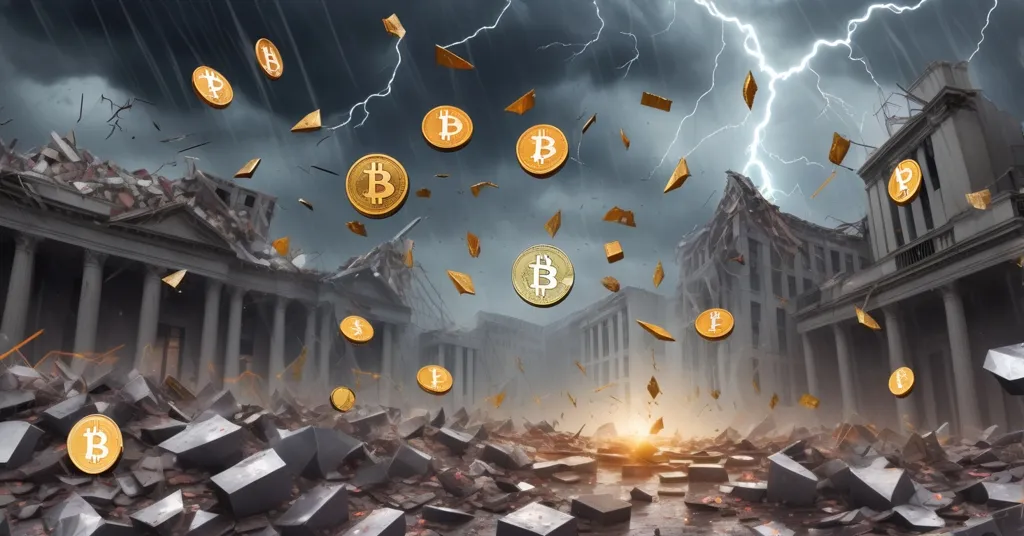Crypto Markets Crash After Trump’s Iran Airstrikes: 3 New Projects Hyped or Hype Traps?

Crypto Markets Reel from Trump’s Iran Airstrikes: Are These 3 New Projects Worth the Hype?
Geopolitical turmoil has rocked the cryptocurrency space, with U.S. President Donald Trump’s ordered airstrikes on Iran’s nuclear facilities on June 21, 2025, sparking a vicious market selloff. As Bitcoin, Ethereum, and altcoins like XRP bleed value, desperate traders are turning to speculative presale tokens—Solaxy ($SOLX), BTC Bull Token ($BTCBULL), and Little Pepe ($LILPEPE)—hoping for a rebound amidst the chaos. But are these projects genuine opportunities or just another mirage in a volatile desert of uncertainty?
- Market Chaos: Iran airstrikes trigger $595M in crypto liquidations, with XRP down 16% in a month.
- Speculative Bets: Traders pivot to untested presale projects as major coins stumble.
- Risky Prospects: Solaxy, BTC Bull Token, and Little Pepe promise innovation but scream high risk.
Why Geopolitical Shocks Hammer Crypto
Before diving into the projects grabbing headlines, let’s set the stage. Global crises have a way of exposing crypto’s raw underbelly. Despite Bitcoin’s oft-touted status as “digital gold,” it’s not a true safe haven when panic grips the markets. The recent U.S. strikes on Iran—targeting nuclear sites like Fordow, Natanz, and Isfahan, key flashpoints in Iran’s controversial nuclear program—sent shockwaves far beyond the Gulf. On June 21, 2025, Trump described the operation as a “spectacular military success,” but Iran countered with warnings of “everlasting consequences.” Oil prices spiked 18% since June 10, hitting $79.04 per barrel, while traditional safe havens like gold surged. Crypto, positioned as a risk-on asset, took a brutal beating. When fear dominates, over-leveraged positions—traders borrowing heavily to amplify gains—get obliterated through forced liquidations (automatic selloffs to cover losses), amplifying the downward spiral. This isn’t just a blip; it’s a reminder that decentralized ideals don’t shield us from global nerves, as discussed in broader analyses of geopolitical impacts on crypto markets.
The Fallout: A Bloodbath in the Crypto Markets
Let’s zoom in on the damage. The airstrikes ignited a fear-driven selloff that torched the crypto landscape. XRP, already on shaky ground, plummeted 16% over the past month, sliding from $2.47 to $2.04. Bitcoin and Ethereum weren’t spared, shedding significant value—Ether alone dropped 8.5% on June 22—before showing faint signs of recovery. The real carnage hit leveraged traders, with over 172,000 accounts wiped out in a 24-hour window, losing $595 million in bullish bets to forced liquidations. That’s the kind of pain that makes even die-hard HODLers rethink their convictions. Analysts like Mark Spindel from Potomac River Capital warn that sustained uncertainty—due to unclear damage assessments and ongoing U.S. engagement in the region—could keep markets on edge, a sentiment echoed in detailed news updates on Middle East tensions. Saul Kavonic of MST Marquee adds that oil could spike to $100 a barrel if Iran retaliates by disrupting Gulf infrastructure, piling on inflation fears and delaying rate cuts. These macro pressures hammer crypto, no matter how much we hype its independence from traditional finance.
But here’s the kicker: crypto’s history shows that chaos often sparks opportunity. Look at the 2022 Russia-Ukraine conflict—Bitcoin dipped 8% in the first week but rallied 15% within a month as use cases like censorship-resistant donations emerged. Even broader markets, like the S&P 500, often recover post-Middle East tensions, up 2.3% two months after initial dips. If tensions de-escalate—some, like Jamie Cox of Harris Financial Group, speculate Iran might seek peace having lost nuclear leverage—crypto could bounce. Yet, Gulf stock markets staying oddly calm post-strikes suggest our volatility is more retail panic and leverage madness than pure economics. While we wait for clarity, traders are hunting for the next big thing, often in the speculative swamp of presales and meme coins, with some insights into this trend available through community discussions on market reactions. Let’s dissect three projects catching fire right now, with a sharp eye for the bullshit.
Solaxy ($SOLX): A Scalability Savior for Solana?
First up is Solaxy, pitched as the pioneering Layer 2 solution on Solana, a blockchain lauded for its speed but dogged by congestion and failed transactions during peak times. For the unversed, a Layer 2 is a secondary framework atop a main blockchain (Layer 1) that offloads transactions to slash costs and boost scalability—imagine a side road easing a jammed highway. Solaxy aims to fix Solana’s bottlenecks while bridging liquidity with Ethereum, creating a multichain hub for DeFi (decentralized finance, a system of financial apps without traditional middlemen) and meme coin trading. Its token, $SOLX, trades at $0.001766, with a staggering $56 million raised in presale as the final buying window closes. The allocation—30% for development, 25% for rewards, and the rest for marketing and liquidity—along with a roadmap targeting full Layer 2 deployment by late 2025 or 2026, paints a structured vision, as highlighted in a comprehensive Solaxy Layer 2 review.
The appeal is clear: faster, cheaper trades and tools to counter sniper bots (automated scripts that snap up tokens at launch for quick profits). In a market craving stability after the Iran-driven panic, Solaxy could shine. But let’s not get carried away. Solana’s Layer 2 space is a wild frontier—can Solaxy deliver technically, or is it just leaching off Solana’s name? With $56 million in the bank, a post-launch dump looms if adoption stalls or tokenomics (the economic design of token supply and distribution) falter. Playing devil’s advocate, if Solana’s ecosystem booms in 2026, Solaxy could be its backbone—assuming it dodges the regulatory heat often intensified by crises like these. Governments spooked by volatility might clamp down, choking ambitious projects before they breathe. The jury’s out, and the stakes are sky-high, with deeper technical insights available in Solaxy scalability analysis for 2025.
BTC Bull Token ($BTCBULL): Meme Coin with Bitcoin Bait?
Next, we’ve got BTC Bull Token, a meme coin hitching its wagon to Bitcoin’s price milestones. Unlike the endless stream of animal-themed nonsense, $BTCBULL dangles a unique carrot: holders snag actual Bitcoin rewards when BTC hits markers like $150K or $200K. Priced at $0.002575, it’s raised $7.2 million in presale, though you’re forced to store it in Best Wallet to claim airdrops. It also burns tokens at Bitcoin’s all-time highs to create scarcity and juice value—a slick mechanic if you buy the story. Community sentiment on platforms like Reddit flags transparency issues with the team and marketing tactics, adding a layer of unease, as explored in detailed discussions on BTC Bull Token risks.
Tying a meme coin to Bitcoin’s bullish narrative is a clever nod to maximalist dreams—we’re not shy about rooting for BTC to hit $1 million someday. Bitcoin is the bedrock of this space, a defiant stand against fiat control, and rewarding holders with it feels like a tribute to the cause. But let’s cut the fluff: meme coins are a cesspool of pump-and-dumps. Even with Bitcoin rewards, $BTCBULL’s value rests on hype and BTC’s price action—hardly a safe bet when markets are reeling from airstrike fallout. The Best Wallet mandate reeks of a centralized choke point, anathema to decentralization. If Bitcoin stumbles, this token’s entire gimmick collapses like a sandcastle at high tide. On the flip side, if BTC surges post-crisis, could this be a quirky winner? Maybe, but only for those willing to gamble with transparency red flags waving in their face, with more information available at the official BTC Bull Token site.
Little Pepe ($LILPEPE): Meme Madness on a Custom Chain?
Rounding out the trio is Little Pepe, a meme coin built on its own EVM-compatible Layer 2 blockchain. For newcomers, EVM (Ethereum Virtual Machine) is the standard for smart contracts—code that runs decentralized apps—on Ethereum and similar networks. Priced at $0.0012, $LILPEPE has pulled in $1.7 million in presale, with early stages selling out fast. It pitches a tailored network for meme traders, offering zero buy/sell taxes, low fees, anti-sniper bot protections, and a launchpad called “Pepe’s Pump Pad” for new meme tokens. Marketed as a safe haven for meme coin chaos, it boasts audited contracts and teases centralized exchange listings soon.
The idea isn’t terrible. Meme coins often get crushed by Ethereum’s gas fees (transaction costs), so a custom Layer 2 could be a lifeline for degens chasing viral tokens. But let’s not kid ourselves: meme coins are 99% hype, 1% utility, and a fancy blockchain doesn’t change the game. The “safe” label feels like slick marketing—how many “audited” projects have rugged investors into the dirt? Success hinges on adoption. If Pepe’s Pump Pad flops, this is just another dead chain with a frog logo. Community metrics on Twitter or Discord might hint at traction, but in a market still stinging from $595 million in liquidations, betting on unproven memes is like tossing dice in a tornado. Could it carve a niche if meme culture explodes again? Sure, but are you ready to risk your stack on that coin flip?
Weighing Risk vs. Reward in Crisis
Here’s the raw truth: the crypto market is a disaster zone after Trump’s Iran airstrikes, with major coins battered and traders grasping for lifelines. Solaxy, BTC Bull Token, and Little Pepe tap into different corners—scalability, Bitcoin loyalty, and meme mania—but they’re all high-stakes rolls of the dice in a storm of uncertainty. Presales have a grim history of overpromising and underdelivering, often leaving retail investors with worthless bags while insiders cash out. That’s not paranoia; it’s a recurring nightmare in this space. Add in the macro mess—oil price spikes, inflation fears, delayed rate cuts—and speculative assets like these look even shakier, a trend also noted in emerging crypto projects gaining attention post-crisis.
Yet, there’s another angle. Crises have historically birthed innovation in crypto. Bitcoin rose from the 2008 financial meltdown, a raw rejection of centralized failure. If Solaxy nails Solana’s scaling issues, or if Little Pepe builds a thriving meme hub, they could be stepping stones to the decentralized future we fight for. Even $BTCBULL, for all its meme absurdity, echoes Bitcoin’s ethos of rewarding conviction. Volatility isn’t just pain; it’s the forge where the next big shift gets hammered out. And if Gulf tensions ease, historical patterns suggest markets, including crypto, often rebound—sometimes stronger for the scars.
Regulatory Storm on the Horizon?
One shadow looms larger post-crisis: regulation. Geopolitical unrest often spurs governments to tighten the screws on crypto, especially when volatility alarms regulators or ties digital assets to illicit funding fears. Look at post-9/11 financial surveillance laws—they reshaped early digital money experiments. Now, with U.S.-Iran tensions flaring, we could see sanctions or crackdowns linking crypto to bypassing traditional controls, a concern reflected in resources like the overview of strategic Bitcoin reserves. Projects like Solaxy, with ambitious cross-chain plans, or meme coins like $LILPEPE, hyping exchange listings, could hit regulatory walls fast. Bitcoin’s decentralized core might weather this better, but altcoins and presales? They’re sitting ducks if lawmakers overreact. This isn’t just a market risk; it’s a systemic one we can’t ignore.
The Path Forward for Crypto Amidst Chaos
So, where do we stand? The market is a powder keg, and these projects are untested sparks. Could de-escalation in the Gulf trigger a crypto rebound, or are we bracing for a prolonged winter? History tilts toward recovery, but only for those who dodge the scams and survive the turbulence. Bitcoin remains the bedrock—its decentralized spine outlives any airstrike or altcoin hype. If you’re eyeing these presales, do your own damn research (DYOR) and don’t wager what you can’t lose. We’re all about pushing adoption and effective accelerationism here, but not by swallowing false promises or ignoring the scummy underbelly of this space. The road to true decentralization is paved with brilliance and garbage—walk it with eyes wide open.
Key Questions and Takeaways
- How did Trump’s Iran airstrikes in 2025 impact the crypto market?
The strikes on June 21, 2025, sparked panic selling, with XRP crashing 16%, Bitcoin and Ethereum sliding, and $595 million in liquidations devastating leveraged traders in just 24 hours.
- Why do geopolitical crises hit crypto so hard?
Crypto, often viewed as a risk-on asset, suffers from panic selling and over-leveraged positions during global unrest, despite Bitcoin’s “digital gold” narrative, as fear overrides decentralized ideals.
- What makes Solaxy ($SOLX) a potential standout in this chaos?
As a Layer 2 fix for Solana’s scalability issues, Solaxy raised $56 million in presale, promising faster, cheaper trades—but untested tech and regulatory risks cast doubt on its future.
- Is BTC Bull Token ($BTCBULL) a clever Bitcoin play or a meme coin trap?
With $7.2 million raised at $0.002575, its Bitcoin reward system tied to price highs is intriguing, yet transparency issues and centralized wallet rules raise major red flags.
- Can Little Pepe ($LILPEPE) redefine meme coin trading?
Priced at $0.0012 with $1.7 million in presale, its custom Layer 2 offers low fees for meme traders, but adoption is uncertain in a space littered with failed hype projects.
- Should you gamble on presales during market volatility?
While presales feed on rebound speculation, their track record of scams and overpromise means extreme caution is non-negotiable—especially amidst geopolitical shocks.
- How can Bitcoin weather geopolitical storms long-term?
Bitcoin’s decentralized core and history of post-crisis recovery, like post-Ukraine war rallies, suggest resilience, positioning it as a safer bet than unproven altcoins or presales.



